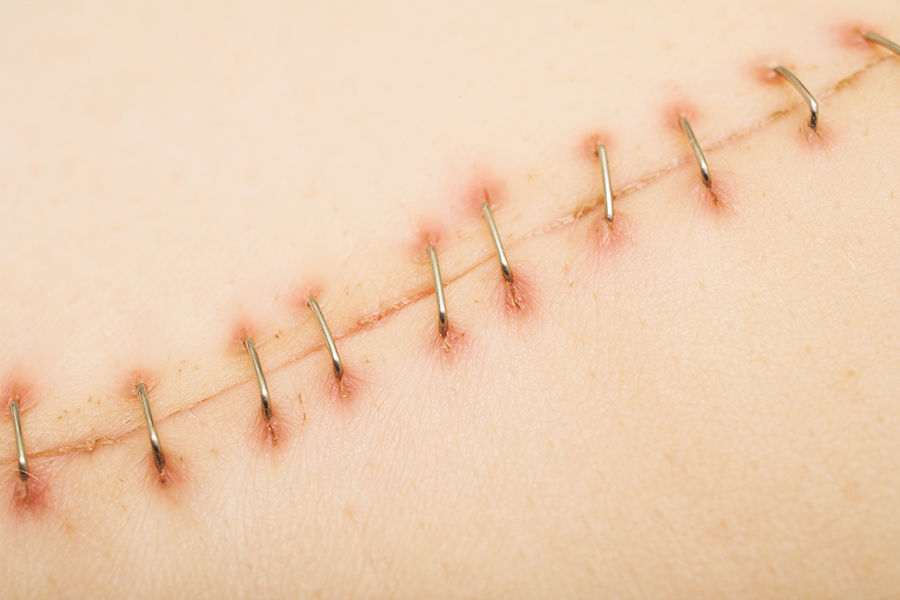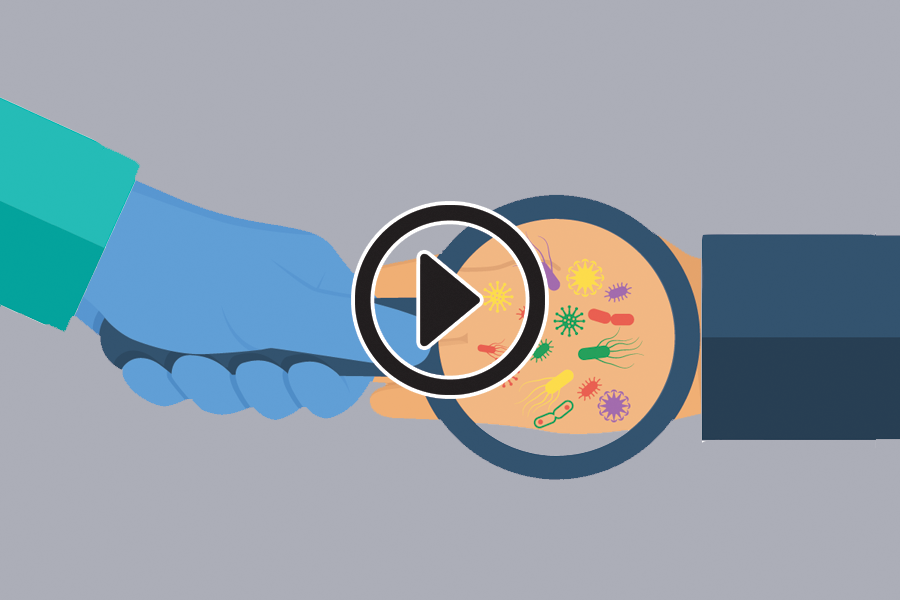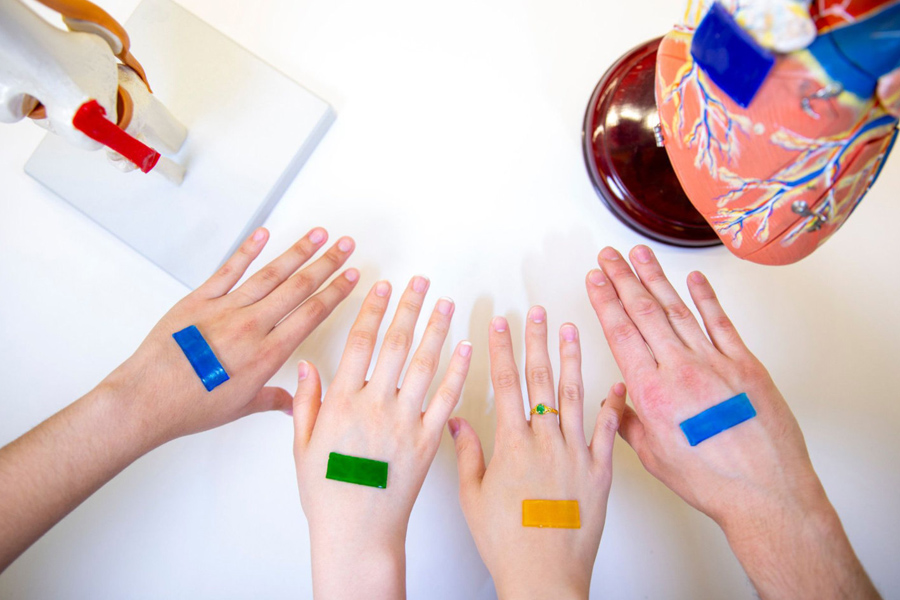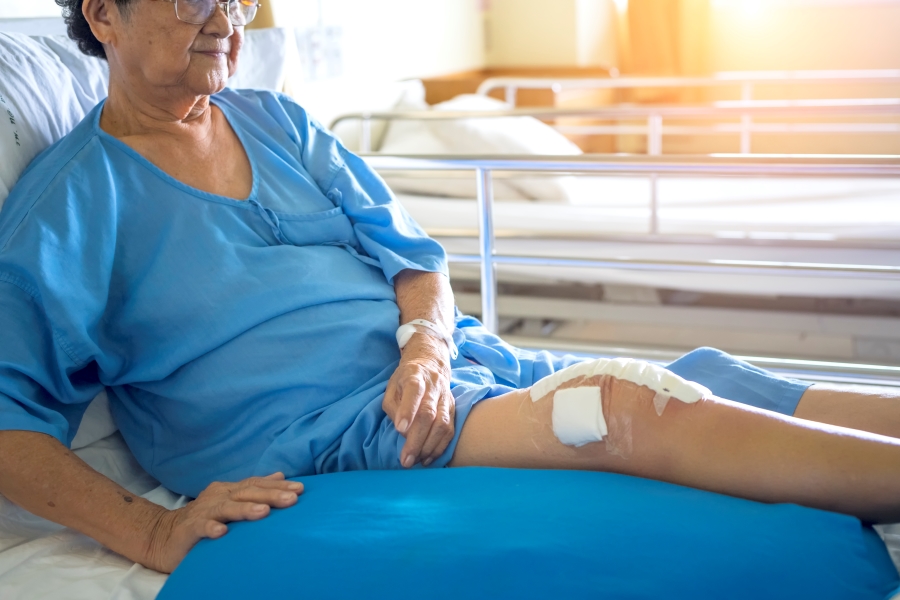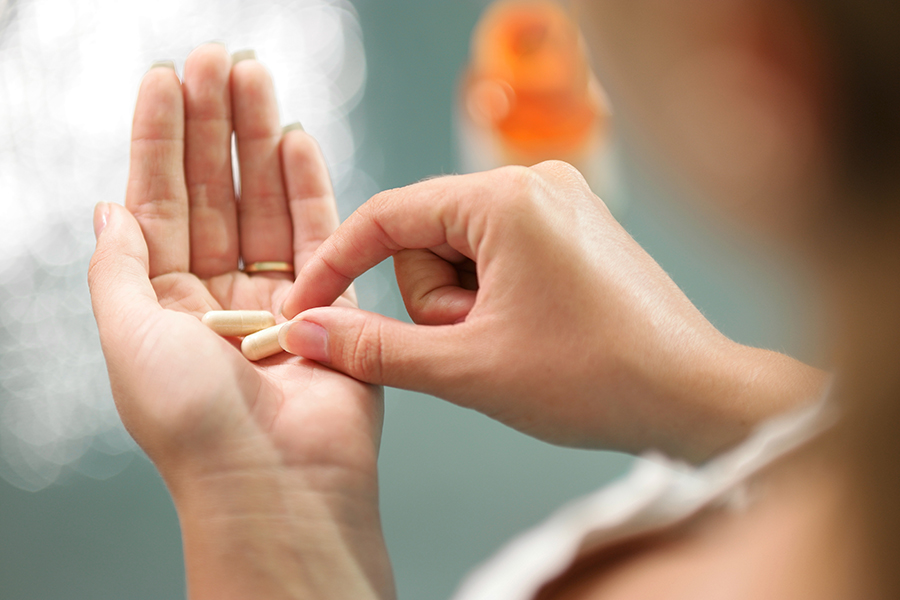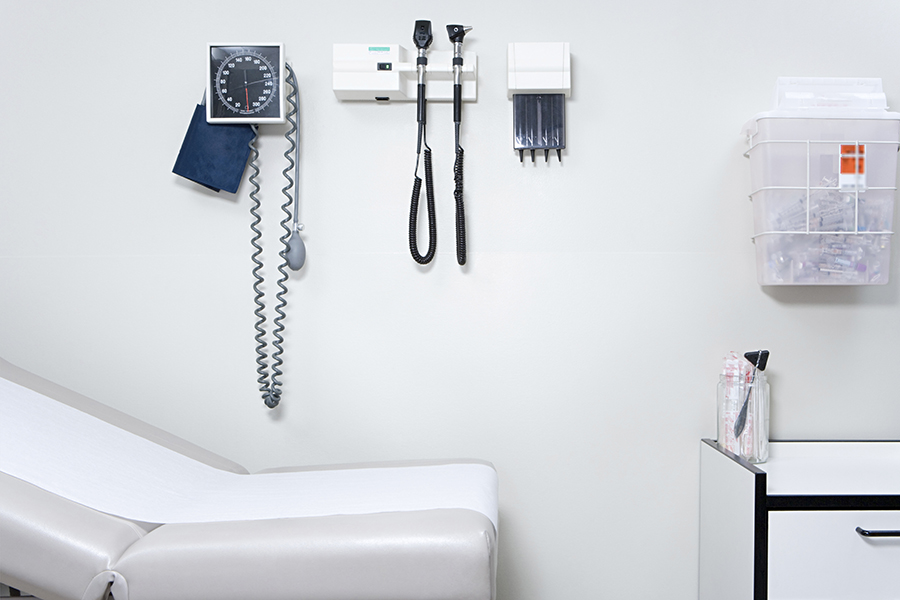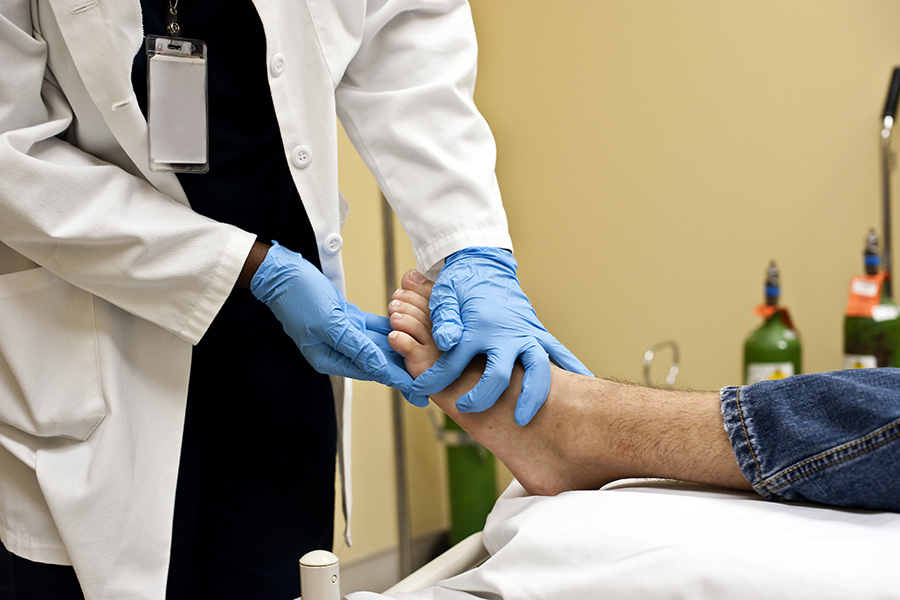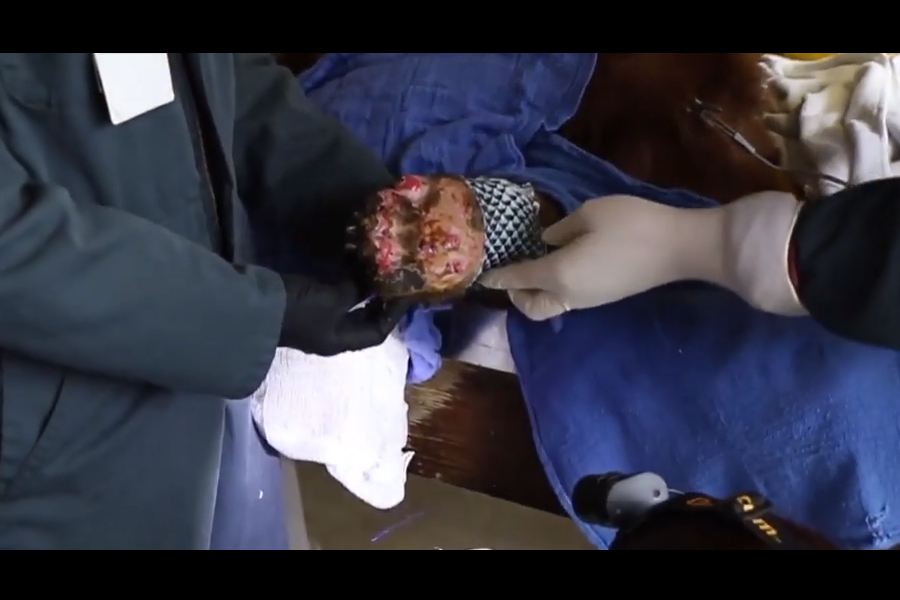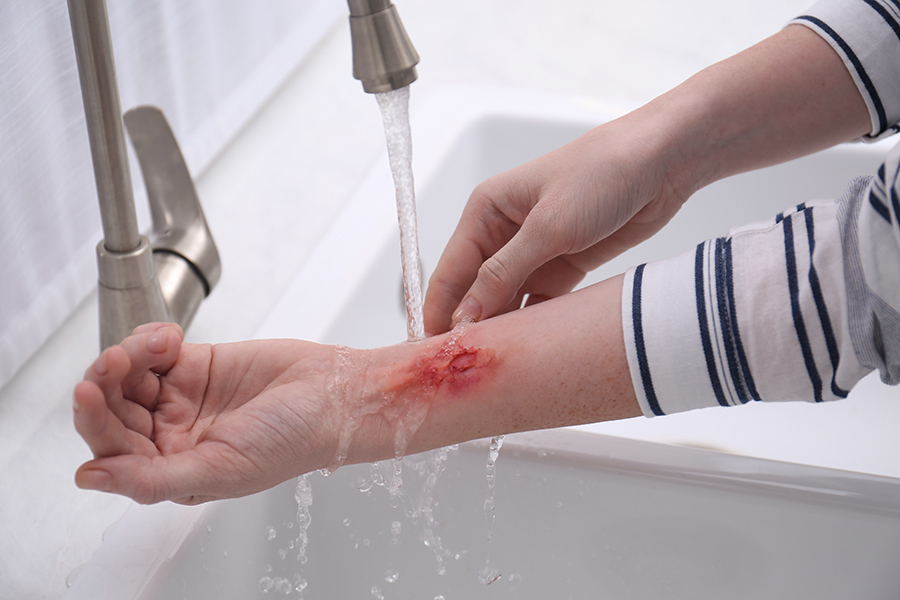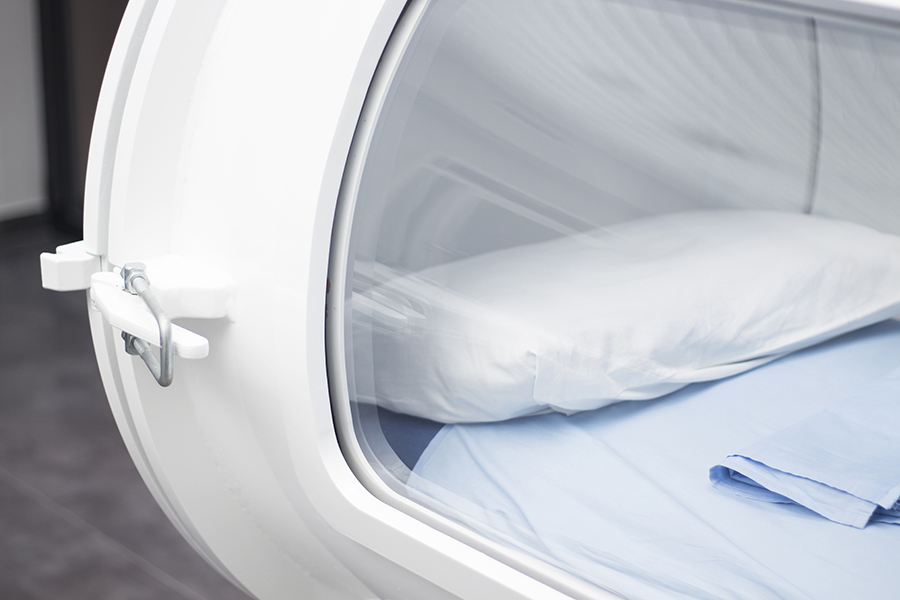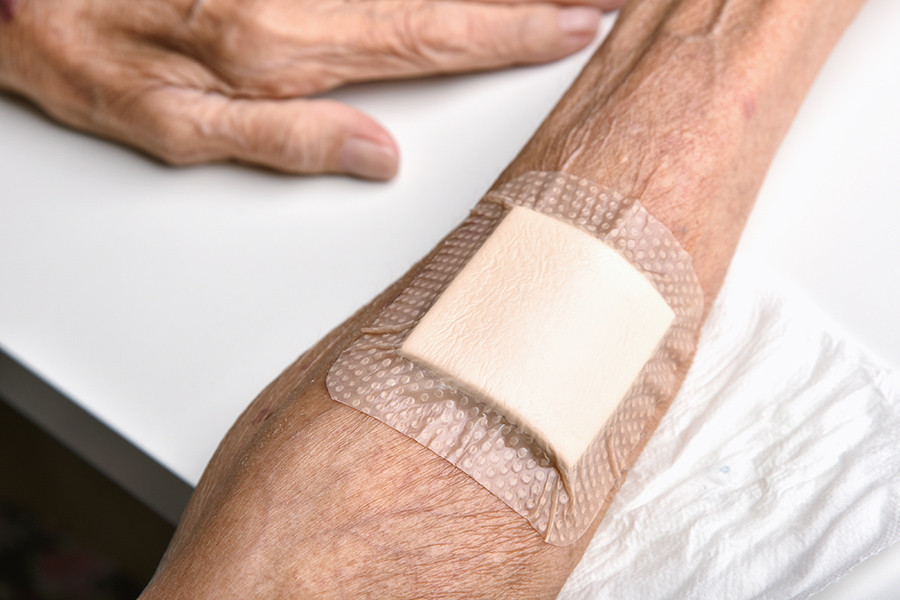A laceration is a torn or jagged open wound through the skin. Lacerations can be caused by blunt trauma, such as a blow, fall, collision, puncture or bite. To begin recovery, a healthcare professional will assess, clean and dress the wound. The depth, location, and cause of your wound, among multiple other factors (including patient preference) will affect the treatment choices made by your physician. Any additional care will depend on the type of laceration or wound. It may be closed with stitches, staples, tape (like “Steri-Strips™”), or skin glue (like “Dermabond®”). The main purposes of these treatments are to stop the bleeding and to help the wound heal with reduced scarring.
After returning home from the hospital or outpatient clinic, follow the instructions below to help your wound heal as quickly as possible and to reduce your chance of infection.
The instructions below can also be followed for post-operative closed incisions.
How to Care for a Wound at Home
Keep the wound clean and dry for the first 24-48 hours. The wound most likely has had a bandage applied, unless skin glue was used, or unless the wound was in a hard-to-bandage area, like the scalp. Most bandages for lacerations can be removed after 24-48 hours, unless indicated otherwise by your doctor. After the bandage is removed, no further dressings are necessary unless your doctor has instructed you to re-apply bandages to the wound at home.
Caring for a Sutured or Stapled Wound
After 48 hours, clean the area with mild soap and water twice a day or as indicated by your doctor. Avoid using hydrogen peroxide, iodine-based solutions, or alcohol. In addition to being painful, these products can damage healthy cells that are essential to wound healing, which can slow the overall healing process.
With your doctor’s approval, you may cover the wound with a thin layer of antibiotic ointment – such as Bacitracin or Neosporin® – twice a day. The antibiotic ointment will help to create a moist, clean healing environment. Some people can develop allergic skin rashes to topical antibiotics, especially neomycin (a component of Neosporin), so you should avoid this step if you have a known sensitivity.
Sutures and staples should be removed within three days to two weeks, depending on where on your body they are located. If dissolving sutures were used, removing them may not be necessary.
The optimal time frame for suture removal is:
| Location | Number of days |
|---|---|
| Face | 3–5 |
| Scalp | 7 |
| Chest and extremities | 8–10 |
| High-tension areas (joints, hands) | 10-14 |
| Back | 10-14 |
Keep in mind that this is just a general guideline. Specific situations related to the wound, as well as other medical conditions, may be a factor in when your sutures are removed.
Caring for a Glued Wound
Skin adhesive glues like Dermabond are sometimes used instead of stitches to close lacerations. When the adhesive dries, it forms a film that holds the edges of the wound together. Skin adhesives are sometimes called “liquid stitches.”
Bandages are not typically placed over a wound closed with adhesive glue because the glue acts like a dressing in and of itself. In addition, home treatment with antibiotic ointment is generally not advised for a wound closed with skin glue. This is because creams and ointments can cause the glue to prematurely slough off.
Concerns
You may have some swelling, color changes, and bloody crusting on or around the wound for 2 or 3 days. This can be normal, and doesn’t mean the glue isn’t working. The glue will naturally slough off in about 5-7 days. At this time, scar tissue will be forming under the surface of the wound and your body will do the rest of the work to heal.
Important things to remember:
- Keep the adhesive film dry for the first 24 hours.
- Do not scratch, rub, or pick at the adhesive.
- Do not put tape directly over the adhesive.
- After the first 24 hours, you can shower with a skin adhesive in place – but do not soak the area in water. Do not go swimming, and be sure to gently dry the area after it gets wet.
Caring for a Wound Closed with Hair Apposition (HAT trick)
An alternative technique for closing lacerations in the scalp is the Hair Apposition Technique, also known as the HAT trick. This technique involves using the scalp hairs as suture ties already embedded in the skin, and it is secured with skin glue or adhesive. Hair apposition is an evidence-based technique, and it has been studied for safe use in lacerations as long as 10 cm.
If the wound was closed with hair apposition, no return visit is necessary to have stitches or staples removed. Keep the area clean and dry, and avoid shampoos or hair products on the area which can cause the glue to come loose prematurely. The glue will naturally dissolve in about five days, after which time your hair strands will unravel.
Caring for a Wound Closed With Tape
Tape strips can be less painful to apply and come with a lower risk of infection, however they do require more caution at home because they are more fragile than other skin closure techniques. Tape strips should not be used on any area of the body considered to be under significant tension.
It is important to:
- Keep the tape clean and dry. It is particularly important to keep the tape dry for the first 48 hours.
- Avoid picking at the tape or rubbing the area
- Avoid soaking in water (showering is okay–bathing is not)
The tape strips will fall off on their own in about 5-7 days (if they don’t, you can gently remove them or soak the wound in water to loosen them). At this time, scar tissue will be forming under the surface of the wound and your body will do the rest of the work of healing.
Caring for a Wound That was Intentionally Left Open
In some cases your doctor may advise leaving the laceration open. This can be for several reasons, but often is because:
- The risk of infection is too high to primarily close the wound (there can be many reasons for this)
- The scar that is expected without closure is cosmetically acceptable to you
Pediatric lacerations to the face are one example of when secondary closure may be suggested over primary closure. For examples of wounds that healed without primary closure, click here. In other situations, your doctor may recommend “delayed primary closure.” This may be suggested for wounds with higher risk of infection, to make sure no infection is developing before the wound is closed. With delayed primary closure, the wound is cleaned and then observed for a few days, before it is surgically closed. Examples of wounds that are closed in this way include traumatic injuries such as dog bites, or lacerations involving foreign bodies.
If your wound was left open, follow your doctor’s instructions. Keep the area clean, use topical antibiotic ointment twice daily or as recommended by your doctor, and watch for signs of infection (see below).
After the Stitches/Staples/Glue/Tape Come Off
The most vulnerable time for a wound is during the first few days right after the closure material has been removed. This is when a wound is most susceptible to dehiscence (opening up). Be careful to avoid activities that could put your wound under unnecessary and/or excessive tension forces.
Any wound that passes through the full thickness of the skin will cause a permanent scar. This scar may be very prominent at first, but tends to gradually improve over the course of about a year. Protect the healing wound from excessive sunlight, which can darken the final appearance of a scar. If a year has passed, and you are still not satisfied with the appearance of the scar, you can contact a plastic surgeon to discuss scar revision.
Danger Signs
Call your doctor or seek immediate medical care in an emergency department if:
- The wound is causing new pain, or the pain gets worse. Some pain is normal with a wound, but worsening pain could be signs of an infection.
- The wound starts to bleed and blood soaks through the bandage. (Oozing small amounts of blood is normal.)
- The skin near the wound is cold, pale or changes color.
- There is tingling, weakness, or numbness near the wound that was not previously discussed with your doctor.
- It is difficult to move the area near the wound, and this difficulty was not previously discussed with your doctor.
- There is increased pain, swelling, warmth, or redness around the wound, which could be a sign of infection.
- Red streaks are leading from the wound, or there is pus draining from the wound.
- A fever develops that has no common explanation (such as a cold or virus).
Follow-up Care
Follow-up care is a key part of your treatment and safety. Being treated in the emergency room is only the first step in wound recovery. Even if when you start feeling better, you still need to go to all suggested follow-up appointments and take all medicines exactly as directed by your doctor. This will speed your recovery and help prevent future problems.
Remember to:
- Schedule and go to all appointments, and call your doctor if things are not going as expected.
- If you’ve been prescribed antibiotics, take them as directed. Do not stop taking them just because you feel better. When a course of antibiotics is left unfinished, resistant infections can develop, which are harder to treat.
- Take good care of the wound at home to help it heal quickly and reduce chances of infection.
- While the wound is healing, avoid any activity that could cause the wound to reopen. Use common sense when it comes to activities.
- Avoid unnescessary, copious bacteria exposure: for example, swimming in an ocean or hot tub, or wearing shoes or gloves over a wound for a long period of time, which promotes bacterial growth.
Information provided by Dr. Brian Lin, MD, FACEP on his website lacerationrepair.com. For more information, follow Dr. Lin on Twitter.
Read the original article on lacerationrepair.com
Additional resources: woundeducators.com, wcei.net
For more information, see related articles and wound care resources here:






